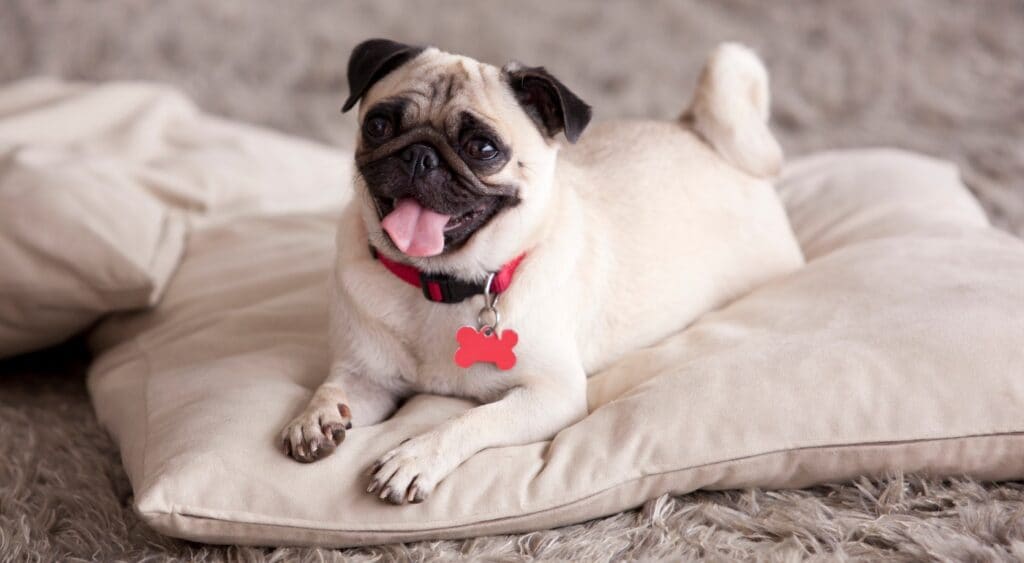It’s pretty easy to fall in love with a Pug. Just look at them! These little dogs have wrinkly, happy faces and delightful personalities. They’re also generally known to be super loving.
Instantly recognizable for their smushed-in faces, expressive bug eyes and curlicue tails, the Pug dog breed can be traced back more than 2,000 years when they were the highly regarded pets of Chinese emperors. According to the American Kennel Club (AKC), these emperors “had a preference for flat-faced toy dogs,” which makes sense when you consider that the Pekingese and Shih Tzu breeds—two other toy breeds with flat faces—also originated in China.
Today, Pugs are ranked among the top 30 most popular dog breeds in America, according to the AKC.
While Pugs undoubtedly are adorable and popular dogs, knowing a bit about the breed before bringing one home is essential to ensure that the pup will be a good fit for you and your family.
1. Pugs Need a Lot of Attention
Personality-wise, Pugs are a social breed who love attention, says Kris Crestejo, CDBC, owner of Modern Canine Training in British Columbia, Canada.
“Pugs are an absolutely lovely companion breed,” she said. “They are very loyal and attached to their humans.”
Your Pug will be your little shadow. So, if you’re thinking about getting one, you’ll want to make sure you can provide him with the attention and affection he seeks.
2. Pugs Are Lively Yet Easy Going
Beyond getting an adorable BFF, you can expect your Pug to be very relaxed and up for anything.
“They’re super enthusiastic, highly trainable, relaxed, fun dogs who love life,” Crestejo says. “This breed can hang out with you happily on the couch for hours or head for a long walk and keep up with ease. They also don’t need tons of exercise and do very well in a small living space.”
3. Pugs Require Some Special Grooming
One of the hallmarks of a Pug dog is his smushed-in face. While cute, their face shape requires some maintenance and are responsible for some of the health issues that Pugs tend to face. Keeping a Pug’s face clean requires active husbandry on the part of the pet parent.
“Due to possible skin-fold infections, regular cleaning of these folds and wrinkles is important,” says Stacey Wylie, DVM, DACVIM, a member of the internal medicine team at NorthStar VETS in Robbinsville, New Jersey.
A simple way to keep your pooch’s precious face clean is to use pet wipes, like Earthbath facial wipes for dogs and cats.
Pugs also are known to be prolific shedders, so managing their coats takes a little extra work. Invest in a good de-shedding dog brush and consider bathing your Pug with shed-control shampoo, like the Shed-X dog shampoo.
4. Pugs Can Suffer From Breathing Problems
Pugs can suffer from breathing issues associated with brachycephalic syndrome. “Brachycephalic” means “short-headed,” according to the American College of Veterinary Surgeons. Dogs with this syndrome have shorter noses than most dogs, and while this gives Pugs their adorable smushy-faced appearance, it also means that they must work harder to breathe than their longer-snouted brethren. Brachycephalic issues can include shortened airways, a narrowed trachea and nasal passages, as well as issues with the soft palate and voice box.
As such, it’s extremely important for Pugs to not overexert themselves, especially when it’s hot outside, Dr. Wylie says.
“Although any dog should not be participating in strenuous exercise or unsupervised outdoor activity in hot or humid weather, brachycephalic dogs can be more susceptible to the effects of this drastic temperature and are more prone to heatstroke and heat-related respiratory issues,” she says.
Dr. Wylie also recommends walking Pugs on a dog harness to limit pressure placed on the upper airways and trachea.
If a Pug sounds like the right fit for your family, Dr. Wylie recommends establishing a relationship with a veterinarian early on to see if your dog may need surgery related to brachycephalic syndrome.
“Surgery could include shortening the soft palate, opening up narrowed airways or removing everted laryngeal saccules—that is, sacs in the voice box that may get turned outwards,” she describes. “If you’re thinking of making one of these dogs a part of your family, please make sure to consult with a veterinarian for more information and ensure that you are giving your little Pug friend the best care possible.”
On a less serious note, Pugs’ shortened airways make them loud breathers, and they’re prone to snorting and snoring.
5. Pugs Are Prone to Weight Gain
Pugs are hearty, muscular little guys, and they are prone to weight gain.
“Due to their relaxed nature, Pugs tend to become overweight easily, so caution and a proper diet should be a top of priority for this breed,” Crestejo says.
There are foods, like the Royal Canin Pug dog food, specially formulated for Pugs to help them maintain a healthy weight.
“Weight management is very important in these dogs, as obesity can exacerbate symptoms of brachycephalic airway disease, orthopedic issues and even put them at risk for conditions that they are not necessarily susceptible to,” Dr. Wylie adds.
While Pugs do require some specialized care, mainly due to their flat faces, it’s clear that this dog breed is worth the effort. It’s no wonder they are one of America’s favorite dog breeds.
By Kate Hughes
Share:













